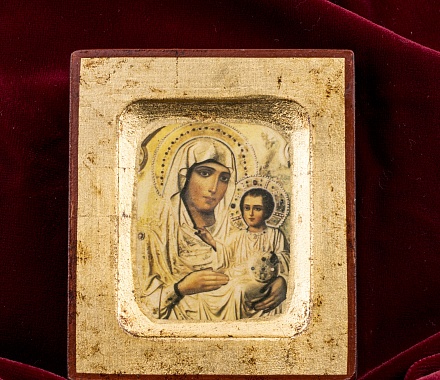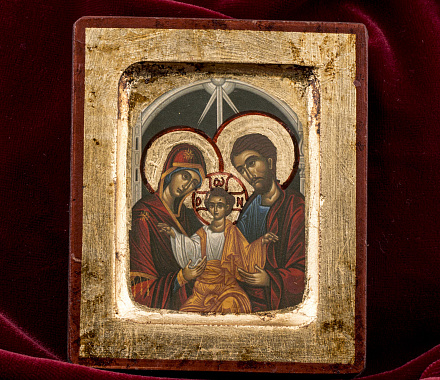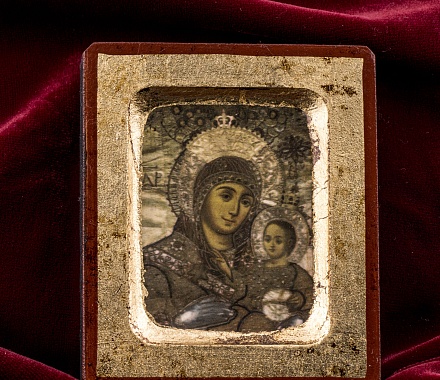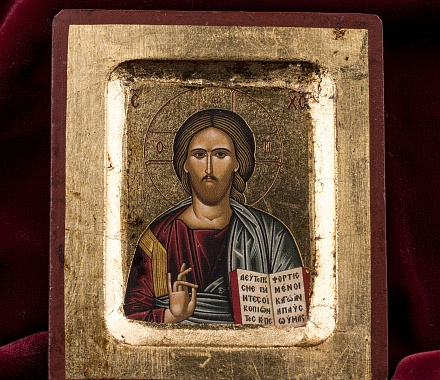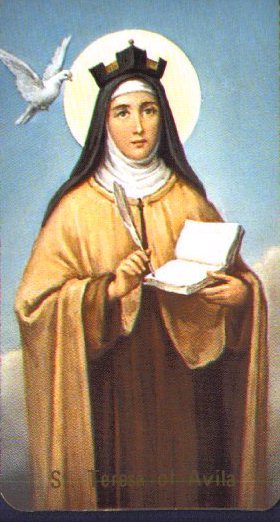
Feastday: October 15
Patron: of Headache sufferers, Spanish Catholic Writers
Birth: March 28, 1515
Death: October 4, 1582
Beatified: April 24th 1614, Rome by Pope Paul V
Canonized: March 12th 1622, Rome by Pope Gregory XV
Teresa of Avila was born Teresa Ali Fatim Corella Sanchez de Capeda y Ahumada in Avila, Spain. Less than twenty years before Teresa was born in 1515, Columbus opened up the Western Hemisphere to European colonization. Two years after she was born, Luther started the Protestant Reformation. Out of all of this change came Teresa pointing the way from outer turmoil to inner peace.
Teresa's father was rigidly honest and pious, but he may have carried his strictness to extremes. Teresa's mother loved romance novels but because her husband objected to these fanciful books, she hid the books from him. This put Teresa in the middle -- especially since she liked the romances too. Her father told her never to lie but her mother told her not to tell her father. Later she said she was always afraid that no matter what she did she was going to do everything wrong.
When she was seven-years-old, she convinced her older brother that they should "go off to the land of the Moors and beg them, out of love of God, to cut off our heads there." They got as far as the road from the city before an uncle found them and brought them back. Some people have used this story as an early example of sanctity, but this author think it's better used as an early example of her ability to stir up trouble.
After this incident she led a fairly ordinary life, though she was convinced that she was a horrible sinner. As a teenager, she cared only about boys, clothes, flirting, and rebelling. When she was 16, her father decided she was out of control and sent her to a convent. At first she hated it but eventually she began to enjoy it -- partly because of her growing love for God, and partly because the convent was a lot less strict than her father.
Still, when the time came for her to choose between marriage and religious life, she had a tough time making the decision. She'd watched a difficult marriage ruin her mother. On the other hand being a nun didn't seem like much fun. When she finally chose religious life, she did so because she though that it was the only safe place for someone as prone to sin as she was.
Once installed at the Carmelite convent permanently, she started to learn and practice mental prayer, in which she "tried as hard as I could to keep Jesus Christ present within me....My imagination is so dull that I had no talent for imagining or coming up with great theological thoughts." Teresa prayed this way off and on for eighteen years without feeling that she was getting results. Part of the reason for her trouble was that the convent was not the safe place she assumed it would be.
Many women who had no place else to go wound up at the convent, whether they had vocations or not. They were encouraged to stay away from the convents for long period of time to cut down on expenses. Nuns would arrange their veils attractively and wear jewelry. Prestige depended not on piety but on money. There was a steady stream of visitors in the parlor and parties that included young men. What spiritual life there was involved hysteria, weeping, exaggerated penance, nosebleeds, and self- induced visions.
Teresa suffered the same problem that Francis of Assisi did -- she was too charming. Everyone liked her and she liked to be liked. She found it too easy to slip into a worldly life and ignore God. The convent encouraged her to have visitors to whom she would teach mental prayer because their gifts helped the community economy. But Teresa got more involved in flattery, vanity and gossip than spiritual guidance. These weren't great sins perhaps but they kept her from God.
Then Teresa fell ill with malaria. When she had a seizure, people were so sure she was dead that after she woke up four days later she learned they had dug a grave for her. Afterwards she was paralyzed for three years and was never completely well. Yet instead of helping her spiritually, her sickness became an excuse to stop her prayer completely: she couldn't be alone enough, she wasn't healthy enough, and so forth. Later she would say, "Prayer is an act of love, words are not needed. Even if sickness distracts from thoughts, all that is needed is the will to love."
For years she hardly prayed at all "under the guise of humility." She thought as a wicked sinner she didn't deserve to get favors from God. But turning away from prayer was like "a baby turning from its mother's breasts, what can be expected but death?"
When she was 41, a priest convinced her to go back to her prayer, but she still found it difficult. "I was more anxious for the hour of prayer to be over than I was to remain there. I don't know what heavy penance I would not have gladly undertaken rather than practice prayer." She was distracted often: "This intellect is so wild that it doesn't seem to be anything else than a frantic madman no one can tie down." Teresa sympathizes with those who have a difficult time in prayer: "All the trials we endure cannot be compared to these interior battles."
Yet her experience gives us wonderful descriptions of mental prayer: "For mental prayer in my opinion is nothing else than an intimate sharing between friends; it means taking time frequently to be alone with him who we know loves us. The important thing is not to think much but to love much and so do that which best stirs you to love. Love is not great delight but desire to please God in everything."
As she started to pray again, God gave her spiritual delights: the prayer of quiet where God's presence overwhelmed her senses, raptures where God overcame her with glorious foolishness, prayer of union where she felt the sun of God melt her soul away. Sometimes her whole body was raised from the ground. If she felt God was going to levitate her body, she stretched out on the floor and called the nuns to sit on her and hold her down. Far from being excited about these events, she "begged God very much not to give me any more favors in public."
In her books, she analyzed and dissects mystical experiences the way a scientist would. She never saw these gifts as rewards from God but the way he "chastised" her. The more love she felt the harder it was to offend God. She says, "The memory of the favor God has granted does more to bring such a person back to God than all the infernal punishments imaginable."
Her biggest fault was her friendships. Though she wasn't sinning, she was very attached to her friends until God told her "No longer do I want you to converse with human beings but with angels." In an instant he gave her the freedom that she had been unable to achieve through years of effort. After that God always came first in her life.
Some friends, however, did not like what was happening to her and got together to discuss some "remedy" for her. Concluding that she had been deluded by the devil, they sent a Jesuit to analyze her. The Jesuit reassured her that her experiences were from God but soon everyone knew about her and was making fun of her.
One confessor was so sure that the visions were from the devil that he told her to make an obscene gesture called the fig every time she had a vision of Jesus. She cringed but did as she was ordered, all the time apologizing to Jesus. Fortunately, Jesus didn't seem upset but told her that she was right to obey her confessor. In her autobiography she would say, "I am more afraid of those who are terrified of the devil than I am of the devil himself." The devil was not to be feared but fought by talking more about God.
Teresa felt that the best evidence that her delights came from God was that the experiences gave her peace, inspiration, and encouragement. "If these effects are not present I would greatly doubt that the raptures come from God; on the contrary I would fear lest they be caused by rabies."
Sometimes, however, she couldn't avoid complaining to her closest Friend about the hostility and gossip that surrounded her. When Jesus told her, "Teresa, that's how I treat my friends" Teresa responded, "No wonder you have so few friends." But since Christ has so few friends, she felt they should be good ones. And that's why she decided to reform her Carmelite order.
At the age of 43, she became determined to found a new convent that went back to the basics of a contemplative order: a simple life of poverty devoted to prayer. This doesn't sound like a big deal, right? Wrong.
When plans leaked out about her first convent, St. Joseph's, she was denounced from the pulpit, told by her sisters she should raise money for the convent she was already in, and threatened with the Inquisition. The town started legal proceedings against her. All because she wanted to try a simple life of prayer. In the face of this open war, she went ahead calmly, as if nothing was wrong, trusting in God.
"May God protect me from gloomy saints," Teresa said, and that's how she ran her convent. To her, spiritual life was an attitude of love, not a rule. Although she proclaimed poverty, she believed in work, not in begging. She believed in obedience to God more than penance. If you do something wrong, don't punish yourself -- change. When someone felt depressed, her advice was that she go some place where she could see the sky and take a walk. When someone was shocked that she was going to eat well, she answered, "There's a time for partridge and a time for penance." To her brother's wish to meditate on hell, she answered, "Don't."
Once she had her own convent, she could lead a life of peace, right? Wrong again. Teresa believed that the most powerful and acceptable prayer was that prayer that leads to action. Good effects were better than pious sensations that only make the person praying feel good.
At St. Joseph's, she spent much of her time writing her Life. She wrote this book not for fun but because she was ordered to. Many people questioned her experiences and this book would clear her or condemn her. Because of this, she used a lot of camouflage in the book, following a profound thought with the statement, "But what do I know. I'm just a wretched woman." The Inquisition liked what they read and cleared her.
At 51, she felt it was time to spread her reform movement. She braved burning sun, ice and snow, thieves, and rat-infested inns to found more convents. But those obstacles were easy compared to what she face from her brothers and sisters in religious life. She was called "a restless disobedient gadabout who has gone about teaching as though she were a professor" by the papal nuncio. When her former convent voted her in as prioress, the leader of the Carmelite order excommunicated the nuns. A vicar general stationed an officer of the law outside the door to keep her out. The other religious orders opposed her wherever she went. She often had to enter a town secretly in the middle of the night to avoid causing a riot.
And the help they received was sometimes worse than the hostility. A princess ordered Teresa to found a convent and then showed up at the door with luggage and maids. When Teresa refused to order her nuns to wait on the princess on their knees, the princess denounced Teresa to the Inquisition.
In another town, they arrived at their new house in the middle of the night, only to wake up the next morning to find that one wall of the building was missing.
Why was everyone so upset? Teresa said, "Truly it seems that now there are no more of those considered mad for being true lovers of Christ." No one in religious orders or in the world wanted Teresa reminding them of the way God said they should live.
Teresa looked on these difficulties as good publicity. Soon she had postulants clamoring to get into her reform convents. Many people thought about what she said and wanted to learn about prayer from her. Soon her ideas about prayer swept not only through Spain but all of Europe.
In 1582, she was invited to found a convent by an Archbishop but when she arrived in the middle of the pouring rain, he ordered her to leave. "And the weather so delightful too" was Teresa's comment. Though very ill, she was commanded to attend a noblewoman giving birth. By the time they got there, the baby had already arrived so, as Teresa said, "The saint won't be needed after all." Too ill to leave, she died on October 4 at the age of 67.
She is the founder of the Discalced Carmelites. In 1970 she was declared a Doctor of the Church for her writing and teaching on prayer, one of two women to be honored in this way.
St. Teresa is the patron saint of Headache sufferers. Her symbol is a heart, an arrow, and a book. She was canonized in 1622.
For other people with similar names, see Saint Teresa. Roman Catholic saint
| Part of a series on | |||||||||||||||||||||||||||||
| Christian mysticism | |||||||||||||||||||||||||||||
|---|---|---|---|---|---|---|---|---|---|---|---|---|---|---|---|---|---|---|---|---|---|---|---|---|---|---|---|---|---|
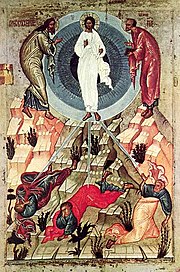 | |||||||||||||||||||||||||||||
Theology · Philosophy
|
|||||||||||||||||||||||||||||
Practices
|
|||||||||||||||||||||||||||||
People (by era or century)
|
|||||||||||||||||||||||||||||
Literature · Media
|
|||||||||||||||||||||||||||||
|
Teresa of Ávila, born Teresa Sánchez de Cepeda y Ahumada, also called Saint Teresa of Jesus (28 March 1515 – 4 or 15 October 1582), was a Spanish noblewoman who felt called to convent life in the Catholic Church. A Carmelite nun, prominent Spanish mystic, religious reformer, author, theologian of the contemplative life and of mental prayer, she earned the rare distinction of being declared a Doctor of the Church, but not until over four centuries after her death. Active during the Catholic Reformation, she reformed the Carmelite Orders of both women and men. The movement she initiated was later joined by the younger Spanish Carmelite friar and mystic John of the Cross. It led eventually to the establishment of the Discalced Carmelites. A formal papal decree adopting the split from the old order was issued in 1580.
Teresa, who had been a social celebrity in her home province, was dogged by early family losses and ill health. In her mature years, she became the central figure of a movement of spiritual and monastic renewal borne out of an inner conviction and honed by ascetic practice. She was also at the center of deep ecclesiastical controversy as she took on the pervasive laxity in her order against the background of the Protestant reformation sweeping over Europe and the Spanish Inquisition asserting church discipline in her home country. The consequences were to last well beyond her life. One papal legate described her as a "restless wanderer, disobedient, and stubborn femina who, under the title of devotion, invented bad doctrines, moving outside the cloister against the rules of the Council of Trent and her prelates; teaching as a master against Saint Paul's orders that women should not teach."
Her written contributions, which include her autobiography, The Life of Teresa of Jesus and her seminal work The Interior Castle, are today an integral part of Spanish Renaissance literature. Together with The Way of Perfection, her works form part of the literary canon of Christian mysticism and Christian meditation practice, and continue to attract interest from people both within and outside the Catholic Church.
Other associations with Teresa beyond her writings continue to exert a wide influence. A Santero image of the Immaculate Conception of El Viejo, said to have been sent by her with a brother emigrating to Peru, was canonically crowned by Pope John Paul II on 28 December 1989 at the Shrine of El Viejo in Nicaragua. Another Catholic tradition holds that Saint Teresa is personally associated with devotion to the Infant Jesus of Prague, a statue she may have owned. Since her death, her reputation has grown, leading to multiple portrayals. She continues to be widely noted as an inspiration to philosophers, theologians, historians, neurologists, fiction writers and artists, as well as to countless ordinary people interested in Christian spirituality and mysticism.
Forty years after her death, in 1622, Teresa was canonized by Pope Gregory XV. At the time she was considered a candidate for national patron saint of Spain, but this designation was awarded to St. James the Apostle. She has since become one of the patron saints of Spain. However, not until 27 September 1970 did Pope Paul VI proclaim Teresa the first female Doctor of the Church in recognition of her centuries-long spiritual legacy to Catholicism.
Early life
Teresa Sánchez de Cepeda y Ahumada was born in 1515 in Ávila, Spain. Her paternal grandfather, Juan Sánchez de Toledo, was a marrano or Converso, a Jew forced to convert to Christianity or emigrate. When Teresa's father was a child, Juan was condemned by the Spanish Inquisition for allegedly returning to the Jewish faith, but he was later able to assume a Catholic identity. Her father, Alonso Sánchez de Cepeda, was a successful wool merchant and one of the wealthiest men in Ávila. He bought a knighthood and assimilated successfully into Christian society.
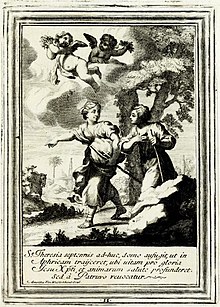 Teresa of Ávila elopes to travel to Africa by Arnold van Westerhout
Teresa of Ávila elopes to travel to Africa by Arnold van Westerhout
Previously married to Catalina del Peso y Henao, with whom he had three children, in 1509, Sánchez de Cepeda married Teresa's mother, Beatriz de Ahumada y Cuevas, in Gotarrendura.
Teresa's mother brought her up as a dedicated Christian. Fascinated by accounts of the lives of the saints, she ran away from home at age seven, with her brother Rodrigo, to seek martyrdom in the fight against the Moors. Her uncle brought them home, when he spotted them just outside the town walls.
When Teresa was eleven years old, her mother died, leaving her grief-stricken. This prompted her to embrace a deeper devotion to the Virgin Mary as her spiritual mother. Teresa was also enamored of popular fiction, which at the time consisted primarily of medieval tales of knighthood and works about fashion, gardens and flowers. Teresa was sent to the Augustinian nuns' school at Ávila.
Entry into religious life
After completing her education, she initially resisted the idea of a religious vocation, but after a stay with her uncle and other relatives, she relented. In 1536, aged 20, much to the disappointment of her pious and austere father, she decided to enter the local easy-going Carmelite Convent of the Incarnation, significantly built on top of land that had been used previously as a burial ground for Jews. She took up religious reading on contemplative prayer, especially Osuna’s Third Spiritual Alphabet (1527). Her zeal for mortification caused her to become ill again and she spent almost a year in bed, causing huge worry to her community and family. She nearly died but she recovered, attributing her recovery to the miraculous intercession of St. Joseph. She began to experience bouts of religious ecstasy.
Foundations of spirituality
Her reading of the medieval mystics, consisted of guides to examination of conscience and spiritual exercises and inner contemplation known in mystical terms as oratio recollectionis or oratio mentalis. She also dipped into other mystical ascetical works such as the Tractatus de oratione et meditatione of Peter of Alcantara.
She reported that, during her illness, she had progressed from the lowest stage of "recollection", to the "devotions of silence" and even to the "devotions of ecstasy", which was one of perceived "perfect union with God" (see § Mysticism). During this final stage, she said she frequently experienced the rich "blessing of tears". As the Catholic distinction between mortal and venial sin became clear to her, she came to understand the awful horror of sin and the inherent nature of original sin. She also became conscious of her own natural impotence in confronting sin and the need for absolute surrender to God.
Around the same time, she received a copy of the full Spanish translation of St. Augustine's autobiographical work Confessions, which helped her resolve and to tend to her own bouts of religious scruples. The text helped her realize that holiness was indeed possible and she found solace in the idea that such a great saint was once an inveterate sinner. In her autobiography, she wrote that she 'was very fond of St. Augustine...for he was a sinner too.'
Around 1556, friends suggested that her newfound knowledge could be of diabolical and not of divine origin. She had begun to inflict mortifications of the flesh upon herself. But her confessor, the Jesuit Francis Borgia, reassured her of the divine inspiration of her thoughts. On St. Peter's Day in 1559, Teresa became firmly convinced that Jesus Christ had presented Himself to her in bodily form, though invisible. These visions lasted almost uninterruptedly for more than two years. In another vision, a seraph drove the fiery point of a golden lance repeatedly through her heart, causing her an ineffable spiritual and bodily pain:
I saw in his hand a long spear of gold, and at the point there seemed to be a little fire. He appeared to me to be thrusting it at times into my heart, and to pierce my very entrails; when he drew it out, he seemed to draw them out also, and to leave me all on fire with a great love of God. The pain was so great, that it made me moan; and yet so surpassing was the sweetness of this excessive pain, that I could not wish to be rid of it...
The account of this vision was the inspiration for one of Bernini's most famous works, the Ecstasy of Saint Teresa at Santa Maria della Vittoria in Rome. Although based in part on Teresa's description of her mystical transverberation in her autobiography, Bernini's depiction of the event is considered by some to be highly eroticized, especially when compared to the entire preceding artistic Teresian tradition.
The memory of this episode served as an inspiration throughout the rest of her life, and motivated her lifelong imitation of the life and suffering of Jesus, epitomized in the adage often associated with her: "Lord, either let me suffer or let me die."
Embarrassment of raptures
Teresa, who became a celebrity in her town dispensing wisdom from behind the convent grille, was also known for her raptures, which sometimes involved levitation. It was a source of embarrassment to her and she bade her sisters hold her down when this occurred. Subsequently, historians, neurologists and psychiatrists like Peter Fenwick and Javier Alvarez-Rodriguez, among others, have taken an interest in her symptomatology. The fact that she wrote down virtually everything that happened to her during her religious life means that an invaluable and exceedingly rare medical record from the 16th century has been preserved. Examination of this record has led to the speculative conclusion that she may have suffered from temporal lobe epilepsy.
Monastic reformer
Over time, Teresa found herself increasingly at odds with the spiritual malaise prevailing in her convent of the Incarnation. Among the 150 nuns living there, the observance of cloister, designed to protect and strengthen spiritual practice and prayer, became so lax that it appeared to lose its purpose. The daily invasion of visitors, many of high social and political rank, disturbed the atmosphere with frivolous concerns and vacuous conversation. Such intrusions in the solitude essential to develop and sustain contemplative prayer so grieved Teresa that she longed to intervene.
The incentive to take the practical steps inspired by her inward motivation was supported by the Franciscan priest, Peter of Alcantara, who met her early in 1560 and became her spiritual adviser. She resolved to found a "reformed" Carmelite convent, correcting the laxity which she had found at the Incarnation convent and elsewhere besides. Guimara de Ulloa, a woman of wealth and a friend, supplied the funds for the project.
The abject poverty of the new convent, established in 1562 and named St. Joseph's (San José), at first caused a scandal among the citizens and authorities of Ávila, and the small house with its chapel was in peril of suppression. However, powerful patrons, including the local bishop, coupled with the impression of well ordered subsistence and purpose, turned animosity into approval.
In March 1563, after Teresa had moved to the new convent house, she received papal sanction for her primary principles of absolute poverty and renunciation of ownership of property, which she proceeded to formulate into a "constitution". Her plan was the revival of the earlier, stricter monastic rules, supplemented by new regulations including the three disciplines of ceremonial flagellation prescribed for the Divine Office every week, and the discalceation of the religious. For the first five years, Teresa remained in seclusion, mostly engaged in prayer and writing.
 Church window at the Convent of St Teresa
Church window at the Convent of St Teresa
Extended travels
In 1567, Teresa received a patent from the Carmelite General, Rubeo de Ravenna, to establish further houses of the new order. This process required many visitations and long journeys across nearly all the provinces of Spain. She left a record of the arduous project in her Libro de las Fundaciones. Between 1567 and 1571, reformed convents were established at Medina del Campo, Malagón, Valladolid, Toledo, Pastrana, Salamanca, and Alba de Tormes.
As part of the original patent, Teresa was given permission to set up two houses for men who wished to adopt the reforms. She convinced two Carmelite friars, John of the Cross and Father Anthony of Jesus to help with this. They founded the first monastery of Discalced Carmelite brothers in November 1568 at Duruelo. Another friend of Teresa, Jerónimo Gracián, the Carmelite visitator of the older observance of Andalusia and apostolic commissioner, and later provincial of the Teresian order, gave her powerful support in founding monasteries at Segovia (1571), Beas de Segura (1574), Seville (1575), and Caravaca de la Cruz (Murcia, 1576). Meanwhile, John of the Cross promoted the inner life of the movement through his power as a teacher and preacher.
Opposition to reforms
In 1576, unreformed members of the Carmelite order began to persecute Teresa, her supporters and her reforms. Following a number of resolutions adopted at the general chapter at Piacenza, the governing body of the order forbade all further founding of reformed convents. The general chapter instructed her to go into "voluntary" retirement at one of her institutions. She obeyed and chose St. Joseph's at Toledo. Meanwhile, her friends and associates were subjected to further attacks.
Several years later, her appeals by letter to King Philip II of Spain secured relief. As a result, in 1579, the cases before the inquisition against her, Father Gracian and others, were dropped. This allowed the reform to resume. An edict from Pope Gregory XIII allowed the appointment of a special provincial for the newer branch of the Carmelite religious, and a royal decree created a "protective" board of four assessors for the reform.
During the last three years of her life, Teresa founded convents at Villanueva de la Jara in northern Andalusia (1580), Palencia (1580), Soria (1581), Burgos, and Granada (1582). In total, seventeen convents, all but one founded by her, and as many men's monasteries, were owed to her reforms over twenty years.
Last days
Her final illness overtook her on one of her journeys from Burgos to Alba de Tormes. She died in 1582, just as Catholic Europe was making the switch from the Julian to the Gregorian calendar, which required the excision of the dates of 5–14 October from the calendar. She died either before midnight of 4 October or early in the morning of 15 October, which is celebrated as her feast day. According to the liturgical calendar then in use, she died on the 15th in any case. Her last words were: "My Lord, it is time to move on. Well then, may your will be done. O my Lord and my Spouse, the hour that I have longed for has come. It is time to meet one another."
 Avila, Saint Theresa's statue
Avila, Saint Theresa's statue
Holy relics
| This section needs additional citations for verification. (October 2020) |
She was buried at the Convento de la Anunciación in Alba de Tormes. Nine months after her death the coffin was opened and her body was found to be intact but the clothing had rotted. Before the body was re-interred one of her hands was cut off, wrapped in a scarf and sent to Ávila. Father Gracián cut the little finger off the hand and – according to his own account – kept it with him until it was taken by the occupying Ottoman Turks, from whom he had to redeem it with a few rings and 20 reales. The body was exhumed again on 25 November 1585 to be moved to Ávila and found to be incorrupt. An arm was removed and left in Alba de Tormes at the nuns' request, to compensate for losing the main relic of Teresa, but the rest of the body was reburied in the Discalced Carmelite chapter house in Ávila. The removal was done without the approval of the Duke of Alba de Tormes and he brought the body back in 1586, with Pope Sixtus V ordering that it remain in Alba de Tormes on pain of excommunication. A grander tomb on the original site was raised in 1598 and the body was moved to a new chapel in 1616.
The body still remains there, except for the following parts:
- Rome – right foot and part of the upper jaw
- Lisbon – left hand
- Ronda, Spain – left eye and right hand (the latter was kept by Francisco Franco until his death after Francoist troops captured it from Republican troops during the Spanish Civil War)
- Museum of the Church of the Annunciation, Alba de Tormes – left arm and heart
- Church of Our Lady of Loreto, Paris, France – one finger
- Sanlúcar de Barrameda – one finger
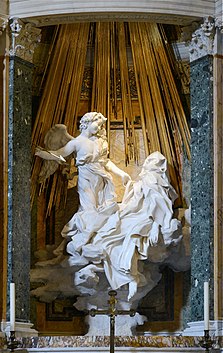 The Ecstasy of Saint Teresa by Bernini, Basilica of Santa Maria della Vittoria, Rome
The Ecstasy of Saint Teresa by Bernini, Basilica of Santa Maria della Vittoria, Rome
Canonization
In 1622, forty years after her death, she was canonized by Pope Gregory XV. The Cortes exalted her to patroness of Spain in 1627. The University of Salamanca had granted her the title Doctor ecclesiae (Latin for "Doctor of the Church") with a diploma in her lifetime, but that title is distinct from the papal honour of Doctor of the Church, which is always conferred posthumously. The latter was finally bestowed upon her by Pope Paul VI on 27 September 1970, along with Saint Catherine of Siena, making them the first women to be awarded the distinction. Teresa is revered as the Doctor of Prayer. The mysticism in her works exerted a formative influence upon many theologians of the following centuries, such as Francis of Sales, Fénelon, and the Port-Royalists. In 1670, her coffin was plated in silver.
Teresa of Avila is remembered in the Church of England with a Lesser Festival on 15 October.
 Statue of Saint Teresa of Ávila in Mafra National Palace, Mafra
Statue of Saint Teresa of Ávila in Mafra National Palace, Mafra
Mysticism
The ultimate preoccupation of Teresa's mystical thought, as consistently reflected in her writings, is the ascent of the soul to God in four stages (see: The Autobiography Chs. 10–22):
- The first, Devotion of the Heart, consists of mental prayer and contemplation. It means the withdrawal of the soul from without, penitence and especially the devout meditation on the passion of Christ (Autobiography 11.20).
- The second, Devotion of Peace, is where human will is surrendered to God. This occurs by virtue of an uplifted awareness granted by God, while other faculties, such as memory, reason, and imagination, are not yet safe from worldly distraction. Although a partial distraction can happen, due to outer activity such as repetition of prayers or writing down spiritual things, the prevailing state is one of quietude (Autobiography 14.1).
- The third, Devotion of Union, concerns the absorption-in-God. It is not only a heightened, but essentially, an ecstatic state. At this level, reason is also surrendered to God, and only the memory and imagination are left to ramble. This state is characterized by a blissful peace, a sweet slumber of at least the higher soul faculties, that is a consciousness of being enraptured by the love of God.
- The fourth, Devotion of Ecstasy, is where the consciousness of being in the body disappears. Sensory faculties cease to operate. Memory and imagination also become absorbed in God, as though intoxicated. Body and spirit dwell in the throes of exquisite pain, alternating between a fearful fiery glow, in complete unconscious helplessness, and periods of apparent strangulation. Sometimes such ecstatic transports literally cause the body to be lifted into space. This state may last as long as half an hour and tends to be followed by relaxation of a few hours of swoon-like weakness, attended by the absence of all faculties while in union with God. The subject awakens from this trance state in tears. It may be regarded as the culmination of mystical experience. Indeed, Teresa was said to have been observed levitating during Mass on more than one occasion.
Teresa is regarded as one of the foremost writers on mental prayer, and her position among writers on mystical theology as unique. Her writings on this theme stem from her personal experiences, thereby manifesting considerable insight and analytical gifts. Her definitions have been used in the Catechism of the Catholic Church. Teresa states: "Contemplative prayer (oración mental), in my opinion is nothing other than a close sharing between friends. It means frequently taking time to be alone with Him whom we know loves us." Throughout her writings, Teresa returns to the image of watering one's garden as a metaphor for mystical prayer.
Writings
 This is the one portrait of Teresa that is probably the most true to her appearance. It is a copy of an original 1576 painting of her when she was 61.
This is the one portrait of Teresa that is probably the most true to her appearance. It is a copy of an original 1576 painting of her when she was 61.
Teresa's writings are regarded as among the most remarkable in the mystical literature of the Catholic Church. They include:
- Teresa of Avila; Lewis, David (1870). The Life of St. Teresa of Jesus ... Written by Herself. Translated from the Spanish by D. Lewis. London: Burns, Oates, & Co.
- Teresa, of Avila (1957). Cohen, J.M. (ed.). The Life Of Saint Teresa Of Avila By Herself. Penguin Classics.
- Teresa of Avila; Zimmerman, Benedict (1997). Life of St. Teresa of Jesus. Tan Books. ISBN 978-0-89555-603-5.
- The Complete Works of St Teresa of Jesus, in five volumes, translated and edited by E. Allison Peers, including 2 volumes of correspondence. London: Sheed and Ward, 1982.
- The Interior Castle. Edited by E. Allison Peers, Doubleday, 1972. ISBN 978-0-385-03643-6
- The Way of Perfection. Translated and Edited by E. Allison Peers, Doubleday, 1991. ISBN 978-0-385-06539-9
- The Life of Teresa of Jesus: The Autobiography of Teresa of Avila. Translated by E. Allison Peers, Doubleday, 1991. ISBN 978-0-385-01109-9
- "Works of St. Teresa of Avila (Online)". Christian Classics Ethereal Library.
- The Interior Castle – The Mansions, TAN Books, 1997. ISBN 978-0-89555-604-2
- The Way of Perfection, TAN Books, 1997. ISBN 978-0-89555-602-8
- Way of Perfection, London, 2012. limovia.net ISBN 978-1-78336-025-3
- The Book of Her Life, translated, with Notes, by Kieran Kavanaugh, OCD and Otilio Rodriguez, OCD. Introduction by Jodi Bilinkoff. Indianapolis/Cambridge: Hackett Publishing Company, 2008. ISBN 978-0-87220-907-7
- Teresa of Avila; Starr, Mirabai (2008). Teresa of Avila: The Book of My Life. Boston, Massachusetts: Shambhala Publications. ISBN 978-1-59030-573-7.
- The Complete Poetry of St. Teresa of Avila. A Bilingual Edition - Edición y traducción de Eric W. Vogt. New Orleans University Press of the South, 1996. Second edition, 2015. xl, 116 p. ISBN 978-1-937030-52-0
- The Autobiography, written before 1567, under the direction of her confessor, Fr. Pedro Ibáñez.
- El Camino de Perfección (The Way of Perfection), written also before 1567, at the direction of her confessor.
- "Meditations on Song of Songs", 1567, written nominally for her daughters at the convent of Our Lady of Mount Carmel.
- El Castillo Interior (The Interior Castle), written in 1577.
- Relaciones (Relationships), an extension of the autobiography giving her inner and outer experiences in epistolary form.
- Two smaller works are the Conceptos del Amor ("Concepts of Love") and Exclamaciones. In addition, there are Las Cartas (Saragossa, 1671), or her correspondence, of which there are 342 extant letters and 87 fragments of others. St Teresa's prose is marked by an unaffected grace, an ornate neatness, and charming power of expression, together placing her in the front rank of Spanish prose writers. The first edition of Teresa's letters was published in 1658 with the comment of Juan de Palafox y Mendoza, Roman Catholic bishop of Osma and an opponent to the Company of Jesus.
- Her rare poems ("Todas las poesías", Munster, 1854) are distinguished for tenderness of feeling and rhythm of thought.
Philosophical works
Christia Mercer, Columbia University philosophy professor, claims that the seventeenth-century Frenchman René Descartes lifted some of his most influential ideas from Teresa of Ávila, who, fifty years before Descartes, wrote popular books about the role of philosophical reflection in intellectual growth. She describes a number of striking similarities between Descartes' seminal work Meditations on First Philosophy and Teresa's Interior Castle.
Excerpts
Teresa, who reported visions of Jesus and Mary, was a strong believer in the efficacy of holy water, claiming to have used it with success to repel evil spirits and temptations. She wrote: "I know from frequent experience that there is nothing which puts devils to flight better than holy water."
The prayer Nada te turbe (Let nothing disturb you) is attributed to Teresa, having been found within her breviary:
Let nothing disturb you.
— Kirvan 1996
Let nothing make you afraid.
All things are passing.
God alone never changes.
Patience gains all things.
If you have God you will want for nothing.
God alone suffices.
A modern prayer Christ has no body but yours, though widely attributed to Teresa, is not found in her writings.
Legacy regarding the Infant Jesus of Prague
The Spanish nuns who established Carmel in France brought a devotion to the Infant Jesus with them, and it became widespread in France.
Though there are no written historical accounts establishing that Teresa of Ávila ever owned the famous Infant Jesus of Prague statue, according to tradition, such a statue is said to have been in her possession and Teresa is reputed to have given it to a noblewoman travelling to Prague. The age of the statue dates to approximately the same time as Teresa. It has been thought that Teresa carried a portable statue of the Child Jesus wherever she went; the idea circulated by the early 1700s.
 "It is love alone that gives worth to all things."
"It is love alone that gives worth to all things."
Patron saint
In 1626, at the request of Philip IV of Spain, the Castilian parliament elected Teresa "without lacking one vote" as copatron saint of Castile. This status was affirmed by Pope Urban VIII in a brief issued on 21 July 1627 in which he stated:
For these reasons [the king's and Cortes's elections] and for the great devotion which they have for Teresa, they elected her for patron and advocate of these kingdoms in the last Cortes of the aforementioned kingdoms.... And because... the representatives in the Cortes desired it so greatly that their vote be firm and perpetual, we grant it our patronage and the approval of the Holy Apostolic See.
— Rowe 2011, pp. 77–78
More broadly, the 1620s, the entirety of Spain (Castile and beyond) debated who should be the country's patron saint; the choices were either the current patron, Saint James Matamoros, or a pairing of him and the newly canonised Saint Teresa of Ávila. Teresa's promoters said Spain faced newer challenges, especially the threat of Protestantism and societal decline at home, thus needing a more contemporary patron who understood those issues and could guide the Spanish nation. Santiago's supporters (Santiaguistas) fought back and eventually won the argument, but Teresa of Ávila remained far more popular at the local level. Saint James the Greater kept the title of patron saint for the Spanish people, and the most Blessed Virgin Mary under the title Immaculate Conception as the sole patroness for the entire Spanish Kingdom.
Portrayals
Portrayals of Teresa include the following:
 Detail of St. Theresa, 1827, by French painter François Gérard
Detail of St. Theresa, 1827, by French painter François Gérard
 Portrait of Sarah Bernhardt as Thérèse in La Vierge d'Avila by Catulle Mendès (1906)
Portrait of Sarah Bernhardt as Thérèse in La Vierge d'Avila by Catulle Mendès (1906)
Music
- Marc-Antoine Charpentier composed two motets for the feast of Saint Teresa: Flores, flores o Gallia for two voices, two flutes and continuo (H.374), c. 1680 and the other, for three voices and continuo (H.342), in 1686-87.
- She is a principal character of the opera Four Saints in Three Acts by the composer Virgil Thomson with a libretto by Gertrude Stein.
- Saint Teresa is the subject of the song "Theresa's Sound-World" by Sonic Youth off the 1992 album Dirty, lyrics by Thurston Moore.
- Saint Teresa is a track on Joan Osborne's Relish album, nominated for a Grammy Award in 1996.
Painting and sculpture
- Saint Teresa was the inspiration for one of Bernini's most famous sculptures, The Ecstasy of St. Teresa in Santa Maria della Vittoria, Rome.
- Teresa was the subject of a portrait by the Flemish master, Sir Pieter Paul Rubens (1615) now in the collection of the Kunsthistorisches Museum, Vienna.
- St. Teresa was painted in 1819–20 by François Gérard, a French neoclassical painter.
Literature
- Simone de Beauvoir singles out Teresa as a woman who lived the human condition (perhaps the only woman to do so) in her book The Second Sex.
- She is mentioned prominently in Kathryn Harrison's novel Poison. The main character, Francisca De Luarca, is fascinated by her life.
- Don DeLillo in End Zone Teresa is depicted as a saint who eats from a human skull to remind herself of final things.
- R. A. Lafferty was strongly inspired by El Castillo Interior when he wrote his novel Fourth Mansions. Quotations from St. Teresa's work are frequently used as chapter headings.
- Pierre Klossowski prominently features Saint Teresa of Ávila in his metaphysical novel The Baphomet.
- George Eliot compared Dorothea Brooke to St. Teresa in Middlemarch (1871–1872) and wrote briefly about the life and works of St. Teresa in the "Prelude" to the novel.
- Thomas Hardy took Saint Teresa as the inspiration for much of the characterisation of the heroine Tess (Teresa) Durbeyfield, in Tess of the d'Urbervilles (1891), most notably the scene in which she lies in a field and senses her soul ecstatically above her.
- The contemporary poet Jorie Graham features Saint Teresa in the poem Breakdancing in her volume The End of Beauty.
- Barbara Mujica's novel Sister Teresa, while not strictly hagiographical, is based upon Teresa's life.
- Timothy Findley's 1999 novel Pilgrim features Saint Teresa as a minor character.
- Vita Sackville-West wrote a double biography contrasting the two Carmelite Theresas, The Eagle and the Dove, re-issued in 2018.
- Zepeda, Reginald (2012). From Spain to Texas: A Cepeda y Ahumada Family Journey. Xlibris. ISBN 9781479770083.
Drama and film
- Performance artist Linda Montano has cited Teresa of Ávila as one of the most important influences on her work and since her return to Catholicism in the 2000s has done performances of her life.
- Teresa de Jesús (1984), directed by Josefina Molina and starring Concha Velasco, is a Spanish made-for-TV mini-series. In it Teresa is portrayed as the determined foundress of new carmelite houses while protecting the infant Jesus statue on her many arduous journeys. The devotion to the Child Jesus spread quickly in Spain, possibly due to her mystical reputation, and then to other places, including France.
- Nigel Wingrove's 1989 short film Visions of Ecstasy was based on Teresa of Ávila. The film features phantasied sexualised scenes of Teresa with the body of Jesus on the cross. It is the only work to be refused certification by the British Board of Film Classification (BBFC) on the grounds of blasphemy.
- Dževad Karahasan. The Delighted Angel drama about Teresa of Ávila and Rabija al-Adavija, Vienna-Salzburg-Klagenfurt, ARBOS 1995.
- Paz Vega stars as Teresa in Teresa, el cuerpo de Cristo, a 2007 Spanish biopic directed by Ray Loriga.
- Marian Álvarez plays the saint in Teresa, a 2015 Spanish television film directed by Jorge Dorado and made for the 500th anniversary of her birth.
- St. Teresa also features prominently in the 2009 Ron Howard film, Angels and Demons, where the Bernini sculpture, The Ecstasy of St. Teresa, is an important clue in helping Robert Langdon (Tom Hanks) find an anti-matter bomb that is hidden in and set to destroy the Vatican.
